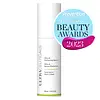What's inside
What's inside
 Key Ingredients
Key Ingredients

 Benefits
Benefits

 Concerns
Concerns

 Ingredients Side-by-side
Ingredients Side-by-side

Water
Skin ConditioningCoco-Caprylate/Caprate
EmollientDimethicone
EmollientGlycerin
HumectantPolysorbate 80
EmulsifyingHydroxyethyl Acrylate/Sodium Acryloyldimethyl Taurate Copolymer
Emulsion StabilisingBisabolol
MaskingStearyl Glycyrrhetinate
Skin ConditioningCetearyl Dimethicone Crosspolymer
Benzyl Alcohol
PerfumingJojoba Esters
EmollientButylene Glycol
HumectantBHT
AntioxidantSodium Hyaluronate
HumectantTocopheryl Acetate
AntioxidantHydroxyethylcellulose
Emulsion StabilisingPropanediol
SolventPolysorbate 20
EmulsifyingRetinol
Skin ConditioningSalicylic Acid
MaskingDisodium EDTA
Polysorbate 60
EmulsifyingSorbitan Isostearate
EmulsifyingClimbazole
AntimicrobialSodium Hydroxide
BufferingSodium Lactate
BufferingCarbomer
Emulsion StabilisingSorbic Acid
PreservativeDisodium Phosphate
BufferingPalmitoyl Tripeptide-5
Skin ConditioningXanthan Gum
EmulsifyingSodium Phosphate
BufferingSaccharide Isomerate
HumectantGlyceryl Caprylate
EmollientBHA
AntioxidantTocopherol
AntioxidantPalmitoyl Tripeptide-1
Skin ConditioningPalmitoyl Tetrapeptide-7
Skin ConditioningWater, Coco-Caprylate/Caprate, Dimethicone, Glycerin, Polysorbate 80, Hydroxyethyl Acrylate/Sodium Acryloyldimethyl Taurate Copolymer, Bisabolol, Stearyl Glycyrrhetinate, Cetearyl Dimethicone Crosspolymer, Benzyl Alcohol, Jojoba Esters, Butylene Glycol, BHT, Sodium Hyaluronate, Tocopheryl Acetate, Hydroxyethylcellulose, Propanediol, Polysorbate 20, Retinol, Salicylic Acid, Disodium EDTA, Polysorbate 60, Sorbitan Isostearate, Climbazole, Sodium Hydroxide, Sodium Lactate, Carbomer, Sorbic Acid, Disodium Phosphate, Palmitoyl Tripeptide-5, Xanthan Gum, Sodium Phosphate, Saccharide Isomerate, Glyceryl Caprylate, BHA, Tocopherol, Palmitoyl Tripeptide-1, Palmitoyl Tetrapeptide-7
Water
Skin ConditioningAlcohol Denat.
AntimicrobialCitric Acid
BufferingLactic Acid
BufferingNiacinamide
SmoothingEthoxydiglycol
HumectantSodium Hydroxide
BufferingSalicylic Acid
MaskingSalix Alba Bark Extract
AstringentCucumis Sativus Fruit Extract
EmollientGlycerin
HumectantHydroxyethylcellulose
Emulsion StabilisingCaprylyl Glycol
EmollientPotassium Sorbate
PreservativeCaprylhydroxamic Acid
Propanediol
SolventIngredients Explained
These ingredients are found in both products.
Ingredients higher up in an ingredient list are typically present in a larger amount.
Glycerin is already naturally found in your skin. It helps moisturize and protect your skin.
A study from 2016 found glycerin to be more effective as a humectant than AHAs and hyaluronic acid.
As a humectant, it helps the skin stay hydrated by pulling moisture to your skin. The low molecular weight of glycerin allows it to pull moisture into the deeper layers of your skin.
Hydrated skin improves your skin barrier; Your skin barrier helps protect against irritants and bacteria.
Glycerin has also been found to have antimicrobial and antiviral properties. Due to these properties, glycerin is often used in wound and burn treatments.
In cosmetics, glycerin is usually derived from plants such as soybean or palm. However, it can also be sourced from animals, such as tallow or animal fat.
This ingredient is organic, colorless, odorless, and non-toxic.
Glycerin is the name for this ingredient in American English. British English uses Glycerol/Glycerine.
Learn more about GlycerinHydroxyethylcellulose is used to improve the texture of products. It is created from a chemical reaction involving ethylene oxide and alkali-cellulose. Cellulose is a sugar found in plant cell walls and help give plants structure.
This ingredient helps stabilize products by preventing ingredients from separating. It can also help thicken the texture of a product.
This ingredient can also be found in pill medicines to help our bodies digest other ingredients.
Learn more about HydroxyethylcellulosePropanediol is an all-star ingredient. It softens, hydrates, and smooths the skin.
It’s often used to:
Propanediol is not likely to cause sensitivity and considered safe to use. It is derived from corn or petroleum with a clear color and no scent.
Learn more about PropanediolSalicylic Acid (also known as beta hydroxy acid or BHA) is a well-known ingredient for treating skin that struggles with acne and clogged pores. It exfoliates both the skin's surface and deep within the pores to help clear out buildup, control oil, and reduce inflammation.
Unlike AHAs (alpha hydroxy acids), salicylic acid is oil-soluble. This allows it to penetrate into pores which makes it especially effective for treating blackheads and preventing future breakouts.
Salicylic acid is also known for its soothing properties. It has a similar structure to aspirin and can calm inflamed or irritated skin, making it a good option for acne-prone skin that is also sensitive.
Concentrations of 0.5-2% are recognized by the U.S. FDA as an over-the-counter topical acne product.
It can cause irritation and/or dryness if one's skin already has a compromised moisture barrier, so it's best to focus on repairing that before introducing this ingredient into your routine.
While salicylic acid does not increase sun sensitivity, it’s still important to wear sunscreen daily to protect your skin.
If you are looking for the ingredient called BHA or Butylated Hydroxyanisole, click here.
Learn more about Salicylic AcidSodium Hydroxide is also known as lye or caustic soda. It is used to adjust the pH of products; many ingredients require a specific pH to be effective.
In small amounts, sodium hydroxide is considered safe to use. However, large amounts may cause chemical burns due to its high alkaline.
Your skin has a natural pH and acid mantle. This acid mantle helps prevent harmful bacteria from breaking through. The acid mantle also helps keep your skin hydrated.
"Alkaline" refers to a high pH level. A low pH level would be considered acidic.
Learn more about Sodium HydroxideWater. It's the most common cosmetic ingredient of all. You'll usually see it at the top of ingredient lists, meaning that it makes up the largest part of the product.
So why is it so popular? Water most often acts as a solvent - this means that it helps dissolve other ingredients into the formulation.
You'll also recognize water as that liquid we all need to stay alive. If you see this, drink a glass of water. Stay hydrated!
Learn more about Water